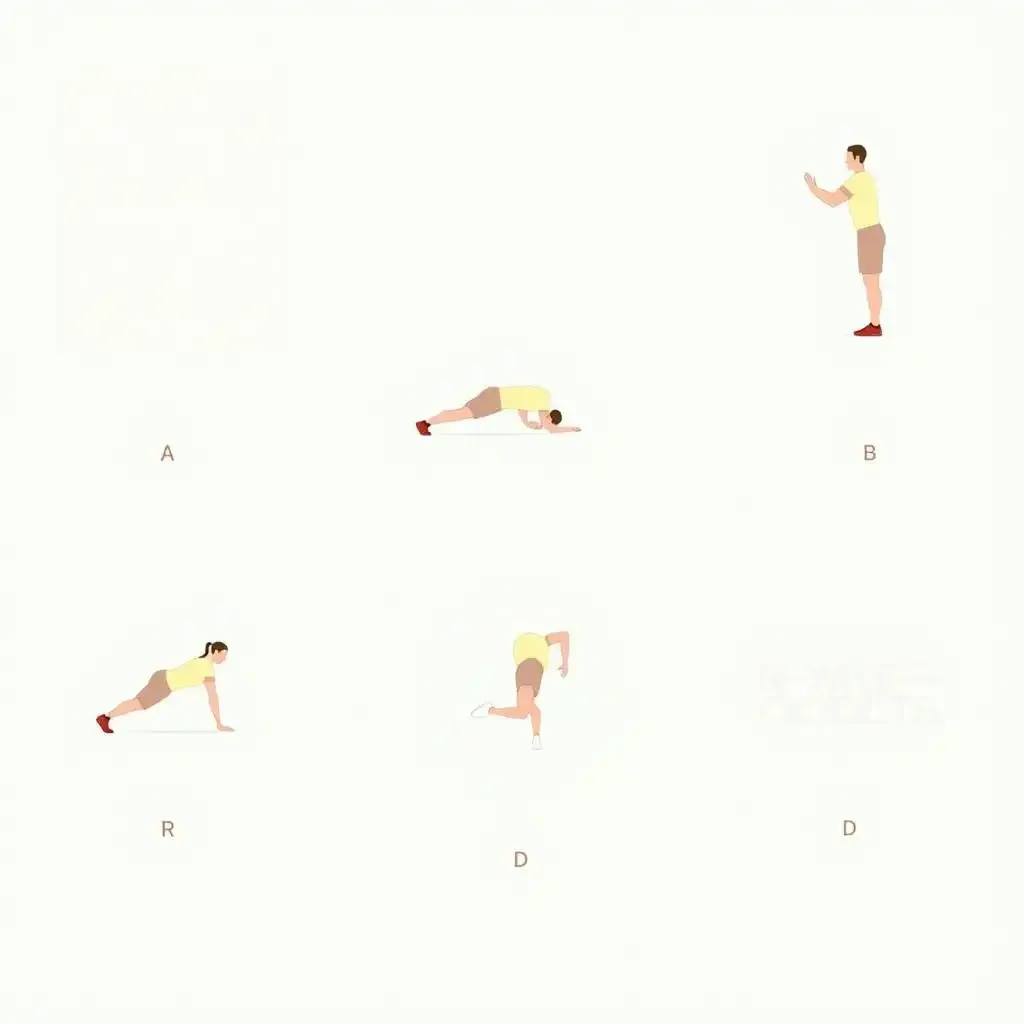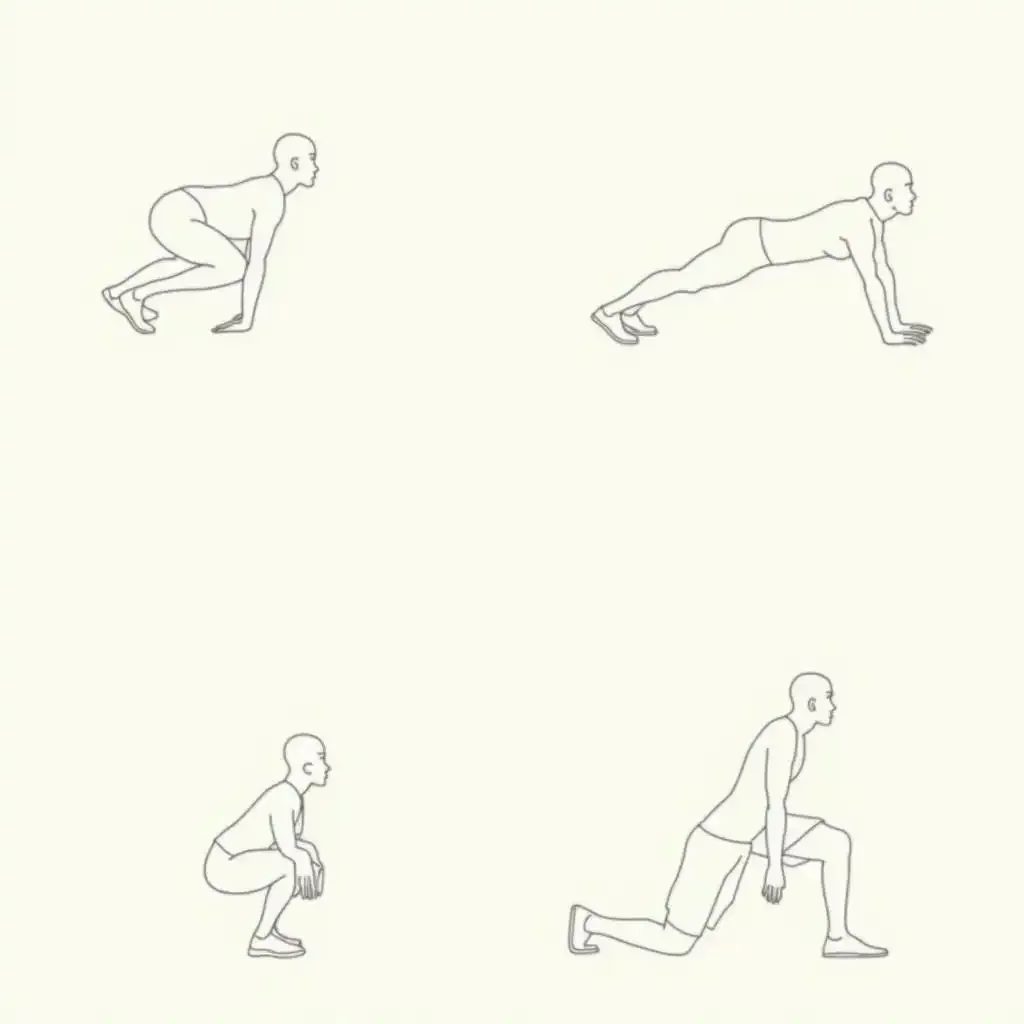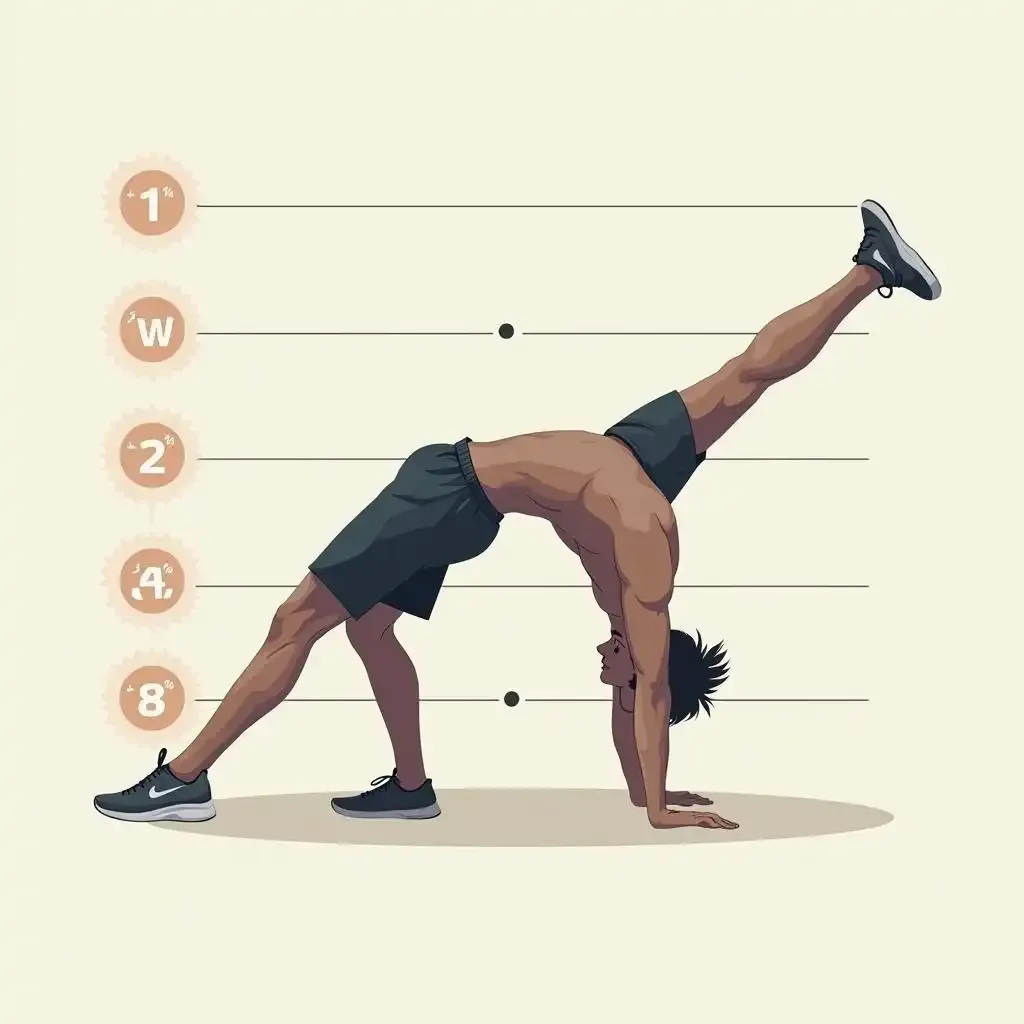Table of Contents
Ready to sculpt your body and boost your strength without expensive gym memberships or complicated equipment? Then get ready to start on a fantastic fitness trip with a beginner calisthenics routine! Calisthenics, simply put, is using your own body weight to build strength, flexibility, and endurance. It’s incredibly accessible – you can do it anywhere, anytime. This guide will equip you with everything you need to start your calisthenics journey, from basic exercises to sample workout plans and progression tips. Whether you're a complete beginner or just looking for a new way to challenge yourself, this beginner calisthenics routine from kizworld will help you reach your fitness goals. We'll show you how to build a solid foundation and safely progress to more challenging exercises. Let's get started and access your inner strength!
Exercise | Sets | Reps | Description |
|---|---|---|---|
Squats | 3 | 10-15 | Stand with feet shoulder-width apart, lower your hips as if sitting in a chair. |
Push-ups | 3 | As many as possible (AMRAP) | Start in a plank position, lower your chest to the floor, and push back up. Modify on knees if needed. |
Walking Lunges | 3 | 10-12 per leg | Step forward with one leg, bending both knees to 90 degrees. Alternate legs. |
Plank | 3 | 30-60 seconds | Hold a straight line from head to heels, engaging your core. |
Glute Bridges | 3 | 15-20 | Lie on your back with knees bent, lift your hips off the floor, squeezing your glutes. |
Ultimate Beginner Calisthenics Routine
Getting Started with Your Beginner Calisthenics Routine
Laying the Foundation: Your First Steps in Calisthenics
Hey there, future calisthenics champion! So you're ready to ditch the gym and embrace the ability of your own body? Awesome! Think of calisthenics as a puzzle – you're building strength piece by piece. We're not aiming for crazy feats of strength right away; we're building a solid base. Start with simple exercises like squats, push-ups (on your knees if needed!), and planks. Remember, consistency is key! Even a few minutes a day is better than nothing. Think of it like brushing your teeth – you do it every day, right? This is the same idea, but for your awesome body. Don't worry about how many reps you can do; focus on good form. You can find more exercise ideas on our calisthenics workouts page. Let's get you moving!
Exercise | Sets | Reps (or Time) |
|---|---|---|
Squats | 3 | 10-15 |
Push-ups (modified if needed) | 3 | As many as possible |
Plank | 3 | 30 seconds |
Building Your Routine: Consistency is King (and Queen!)
Now that you've got a feel for the basics, let's talk about building your routine. Think of it like this: you wouldn't build a house without a plan, right? The same goes for your fitness process. Aim for 3 workouts a week, with rest days in between to let your muscles recover. Don't overdo it; listen to your body! Soreness is normal, but sharp pain means you need to take a break. A good workout routine should include a mix of upper body, lower body, and core exercises. If you're feeling lost, check out our sample weekly plans later in this article. You might also find our guide on how often you should exercise helpful: calisthenics frequency. Remember, consistency is more important than intensity, especially when you're just starting.
- Warm-up before each workout.
- Cool-down after each workout.
- Listen to your body and rest when needed.
Building Strength: Key Beginner Calisthenics Exercises
Mastering the Fundamentals: Squats, Push-ups, and Planks
Let's talk about the holy trinity of beginner calisthenics: squats, push-ups, and planks. These are your foundational movements, the building blocks of a stronger, more flexible you. Squats work your legs and glutes – think of them as your body's powerful engines. Push-ups target your chest, shoulders, and triceps – your upper body's powerhouses. And planks? They're like the secret weapon for a strong core, which is crucial for stability and preventing injuries. Start slow, focus on good form, and gradually increase the number of reps or the time you hold each exercise.
“The body achieves what the mind believes.” – Napoleon Hill. This quote perfectly encapsulates the strength of belief in achieving your fitness goals. Believe in your ability to progress, and you will.
Adding Variety: Beyond the Basics
Once you've mastered the basics, it's time to add some variety! Lunges are amazing for leg strength and balance. Glute bridges help strengthen your glutes – important for posture and preventing lower back pain. And don't forget about your core! Crunches, leg raises, and bicycle crunches will help you build a strong and stable midsection. Remember to check out our calisthenics classes page for more ideas and detailed instructions. It's all about finding a mix of exercises that you enjoy and that challenge you in different ways. And remember, you can always modify exercises to fit your fitness level.
“Progress, not perfection.” This is a great reminder to focus on your ongoing progression and to celebrate your wins along the way.
Beginner Calisthenics Routine: Sample Weekly Plans
A Simple 3-Day Routine
This plan is perfect for beginners. Remember to listen to your body and take rest days when needed. Focus on proper form over quantity. You can always increase the number of reps or sets as you get stronger. If you want to learn more about building your own routines, check out our strength training article: strength training guide.
Day | Workout |
|---|---|
Monday | Squats (3 sets of 10-15 reps), Push-ups (3 sets of as many as possible), Plank (3 sets of 30 seconds) |
Wednesday | Lunges (3 sets of 10-12 reps per leg), Glute Bridges (3 sets of 15-20 reps), Crunches (3 sets of 15-20 reps) |
Friday | Repeat Monday's workout or choose your favorite exercises. |
Stepping it Up: A 4-Day Routine
Ready for a bit more of a challenge? This 4-day routine adds more variety and intensity. Remember, consistency is key! Even if you miss a day, don't beat yourself up. Just get back on track with your next workout. Want to know if calisthenics is enough for you? Check out our article: is calisthenics enough?
- Day 1: Upper Body Focus (push-ups, dips, planks)
- Day 2: Lower Body Focus (squats, lunges, glute bridges)
- Day 3: Rest
- Day 4: Full Body (mix of upper and lower body exercises)
- Day 5 & 6: Rest
- Day 7: Active Rest (light cardio or stretching)
Progressing Your Beginner Calisthenics Routine
Listen to Your Body: Signs of Progress (and When to Slow Down)
Progress isn’t always linear. Some days you'll feel amazing, others you'll struggle. That's totally normal! Notice how your body feels. If you’re consistently hitting your reps with good form and feeling ready for more, it's time to increase the difficulty. This could mean adding more reps, sets, or trying more challenging variations of the exercises. If you notice pain, however, take a break and don't push yourself too hard. You can find out more about how calisthenics can change your body on our page: calisthenics body transformation
“The difference between ordinary and extraordinary is that little extra.” – Jimmy Johnson. This means pushing yourself slightly beyond your comfort zone consistently leads to significant results.
Level Up: Modifying Exercises and Adding Progressions
Once you feel comfortable with the basic exercises, it's time to start progressing. This might mean doing incline push-ups (easier) or decline push-ups (harder). You could also try adding weight to your squats or lunges (with a backpack, for example!). There are tons of ways to progress, and it's all about finding what works best for you. Check out our personal training courses if you’re looking for more personalized guidance: personal training. Remember, progress is a trip, not a race. Enjoy the process!
Getting Started with Your Beginner Calisthenics Routine
Building Strength: Key Beginner Calisthenics Exercises
Mastering the Fundamentals: Squats, Push-ups, and Planks
Right, let's talk about the superstars of any beginner calisthenics routine: squats, push-ups, and planks. Think of these as the three wise monkeys of fitness – see no excuses, hear no complaints, speak no negativity! Squats are like the ultimate leg day – you're working your quads, glutes, and hamstrings. It's like giving your legs a serious strength-up. Push-ups are all about your chest, shoulders, and triceps; imagine them as your body's built-in superhero muscles. Planks, on the other hand, are core strength magic. They're like the invisible support beam holding your entire body together. They're super important for avoiding those pesky backaches. Start slow, I'm not expecting you to conquer the world on day one! Focus on doing them properly. Gradually increase the number of reps as you get stronger. It's all about steady progress, not a sudden super-human transformation. Remember, consistency is key! Even if you only manage a few reps at first, you're building a solid foundation. If you need some extra motivation, check out our strength training guide for some extra inspiration.
Exercise | Muscle Group | Tip |
|---|---|---|
Squats | Legs & Glutes | Keep your back straight! |
Push-ups | Chest, Shoulders, Triceps | Modify on your knees if needed. |
Plank | Core | Engage your core muscles. |
Adding Variety: Beyond the Basics
Okay, so you’ve nailed the basics – fantastic! Now let's spice things up a bit. Think of it like adding different instruments to your band – each one adds a new flavor to the music. Lunges are a total leg workout that also helps with balance. It's like walking on a tightrope, but cooler. Glute bridges are all about those glutes – they're your body's natural shock absorbers and are essential for good posture. And don't forget about your core – it's the powerhouse of your body. Crunches, leg raises, and bicycle crunches will help you build a rock-solid midsection. You'll find yourself standing taller and feeling stronger. Remember, there's tons of information on our calisthenics classes page if you need more ideas. The key is to find a mix that challenges you and keeps you engaged. Remember, it's your body, your rules. Tailor it to what you enjoy.
- Lunges
- Glute Bridges
- Crunches
- Leg Raises
- Bicycle Crunches
Progressing Your Skills: Level Up Your Calisthenics Game
As you get stronger, don't be afraid to challenge yourself! Think of it like leveling up in a video game – each new challenge makes you stronger. For push-ups, you could try incline push-ups (easier) or decline push-ups (harder). Want to make squats harder? Try adding a backpack filled with books! There are so many variations to keep things exciting. You'll find more exercises and progressions on our calisthenics workouts page. The secret is to listen to your body. If something hurts, stop! Don’t push yourself too hard, especially when you're starting. Remember, consistency is key, and even small improvements are a big win. Celebrate those victories! You're building a stronger, healthier, and more awesome you, one rep at a time.
"The body achieves what the mind believes." - Napoleon Hill
Building Strength: Key Beginner Calisthenics Exercises
Beginner Calisthenics Routine: Sample Weekly Plans
A Simple 3-Day Routine: Your Calisthenics Kickstart
Hey there, future fitness fanatic! Let's examine into a simple 3-day routine, perfect for easing into the world of calisthenics. Think of it like learning to ride a bike – you start slow, build confidence, and before you know it, you're cruising! This routine focuses on fundamental exercises, ensuring you build a strong base before tackling more advanced moves. Remember, quality over quantity is key here. Focus on proper form, even if it means fewer reps. It's about building strength and good habits, not just racking up numbers. Want to track your progress? Grab a notebook, or use a fitness app – it’s amazing to see how far you’ve come!
Day | Workout |
|---|---|
Monday | Squats (3 sets of 10-15 reps), Push-ups (3 sets of as many as possible), Plank (3 sets of 30 seconds) |
Wednesday | Lunges (3 sets of 10-12 reps per leg), Glute Bridges (3 sets of 15-20 reps), Crunches (3 sets of 15-20 reps) |
Friday | Rest or Active Recovery (light cardio or stretching) |
Stepping it Up: A 4-Day Routine for Calisthenics Enthusiasts
Feeling ready for a challenge? Fantastic! This 4-day plan adds more variety and intensity, pushing you to grow stronger and more confident. Think of it as adding more instruments to your band – each day brings a new element to your fitness process. It's all about finding a balance between pushing your limits and allowing your body to recover. This routine incorporates rest days and active recovery, which is crucial for preventing injuries and maximizing your gains. Remember, consistency is your superpower. Even if you miss a day, don't stress; just hop back on the calisthenics train the next day! Need some extra support? Check out our for personalized guidance.
- Day 1: Upper Body Focus (push-ups, dips, planks)
- Day 2: Lower Body Focus (squats, lunges, glute bridges)
- Day 3: Rest
- Day 4: Full Body (mix of upper and lower body exercises)
- Day 5 & 6: Rest
- Day 7: Active Rest (light cardio or stretching)
“The greatest of follies is to sacrifice health for any other kind of happiness.” – Arthur Schopenhauer. Prioritize rest and recovery; it's not a sign of weakness, it’s part of the process!
Progressing Your Beginner Calisthenics Routine
So, you've been crushing your beginner calisthenics routine – high five! But now what? Think of your fitness progression like climbing a mountain; you started at the base, and now it's time to pick your path up the slope. The awesome thing about calisthenics is there are tons of ways to make things harder. It's not just about doing more reps; it's about making each exercise more challenging. For example, if push-ups are feeling too easy, try incline push-ups or even decline push-ups. They're the same exercise, but the angle changes everything! It’s like turning up the difficulty in a video game. Need more ideas? Our page has tons more.
Another clever trick is to add time under tension. Instead of quickly doing your reps, try slowing them down. This makes your muscles work harder, leading to greater strength gains. It’s like adding extra weight to your workout, but without the extra weight! Think of it as a secret weapon to boost your results. And don't forget about rest! Your muscles need time to recover and rebuild; it’s where the real magic happens. Skipping rest days is like trying to build a sandcastle during a hurricane – it’s not going to end well. For more info on rest, check out our guide on .
Exercise | Beginner | Intermediate | Advanced |
|---|---|---|---|
Push-ups | Standard push-ups | Incline push-ups | Decline push-ups |
Squats | Bodyweight squats | Jump squats | Pistol squats |
Plank | Standard plank | Side plank | Plank with leg raises |
Remember, your body is your own personal gym. It's a super-powered machine that adapts and gets stronger with each workout. Listen to your body. If something hurts, don't push it. Rest, recover, and come back stronger. It's a marathon, not a sprint! Also, don't be afraid to mix things up. Try new exercises and find what you enjoy. The more fun you have, the more likely you are to stick with it. Want to know if calisthenics is right for you? See our article on .
One of my favorite ways to track my progress is by taking pictures. Before I started calisthenics, I looked like a melted marshmallow. Now, I'm more like a well-defined, toned marshmallow! Okay, maybe not, but seriously, seeing the changes in my body is a HUGE motivator. You can also use a notebook to keep track of your reps and sets. It's amazing to see how much you improve over time. And remember, even small improvements are a huge win. Celebrate those wins! You are awesome!
- Take progress pictures
- Keep a training journal
- Set realistic goals
"The body achieves what the mind believes." - Napoleon Hill
Progressing Your Beginner Calisthenics Routine
Final Thought
Starting a beginner calisthenics routine is a fantastic way to improve your fitness. Remember consistency is key, and listening to your body is crucial. Don't push yourself too hard, especially when starting. Celebrate your small victories, and soon you’ll be amazed by your progress. Enjoy the trip!